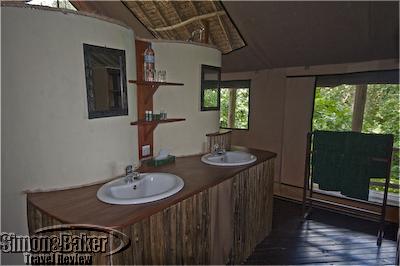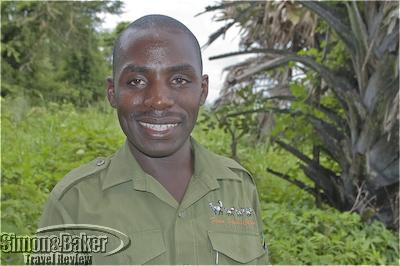

Nestled in a grove of venerable marula and tamarind trees right at the mouth of the Katuma River, Katavi Wilderness Camp was so seamlessly integrated as to all but disappear within its breathtaking surroundings. The spacious tents under thatch that stood on either side of the lodge, each shielded from its neighbors by lush underbrush, were raised on large wooden platforms to overlooked the endless expense of the Katisunga Plain and the outline of the Lyamba-lya-Mfipa escarpment in the distance. The lodge itself, a vast open space of understated rustic elegance under a high thatch roof, featured an upper level lounge for the ultimate viewing perspective. The camp was one of these rare properties where every detail has been thoughtfully considered to ensure my comfort and optimum enjoyment of this exceptional environment, yet nothing was superfluous, so as not to detract from it. But as always in even the best-planned properties, the tipping point is the staff, and at Katavi it clearly tipped to the side of perfection. From Dick Ashcroft, the efficient and attentive camp manager, to Young Henry, the eager to please young Masai dining-room server and bartender (not to be confused with Chef Henry who worked wonders in the kitchen), every member of the friendly staff was personally committed to making my stay with them an unforgettable experience.
I visited Katavi at the start of the green season, usually considered a most favorable time for bird watching, but when game viewing takes more effort than in the dryer months, because ready access to water keeps animals scattered throughout their habitat. My guide, Apollo, a knowledgeable veteran of the park, proved different. Although birding was indeed excellent, Apollo treated me to some of the most leisurely, closest-range game viewing I have ever encountered. He made his way through the lush vegetation encroaching upon the already narrow trails to spots where the animals, unconcerned by a rare human presence, went about their daily life as they have for time immemorial. In the forest, large families of elephants came to browse within an arm’s length of our open-sided vehicle. Herds of zebras unhurriedly made their way across our path, and giraffes came to drink in the puddles on the road. Even the most diffident of antelopes carried on grazing with no more than a cursory glance in our direction. And best of all, not once during my stay at Katavi did we encounter another vehicle, which made for an especially intense wilderness experience.
With its charming accommodations, warm and attentive staff, and its unequaled location in one of the most unspoiled wilderness areas I have visited anywhere in Africa, Katavi Wilderness Camp has become one of my most treasured safari destinations ever.
Children The camp welcomed children of all ages on a case-by-case basis by prior arrangement
Class Of Accommodation Luxury tented bush camp
Communications My GSM 900/1800 compatible international cellular phone service was erratic around the camp and in the park.
Handicapped Access The camp was fully wheelchair accessible. All guest tents as well the entire first floor of the lodge, including the dining room, lounge and bar had ramp access.
Internet Connectivity The camp had a WiFi connection in the manager’s office that could be used to check mail and place internet-based calls. The connection was slow but reliable.
Length Of Stay Three nights
Location In the Rukwa region in western Tanzania, east of Lake Tanganyika
Owned-Managed The Fox family
Pets Allowed No
Size The property consisted of six guest tents that could accommodate a maximum of 12 guests. It employed a staff of seven including two guides. There were three game-watching vehicles.
Year Open-Renovated Katavi Wilderness Camp opened in 2004. It was fully renovated in 2009.
Room My 375 square foot (35 square meter) tent, Number One, sat on an oversized platform that also included a large front veranda. A high peaked thatched roof shaded both tent and veranda. The tent had the usual zippered front entrance and sidewalls with three sets of large netting windows with outside canvas panels that could be zipped down for privacy. The sleeping area occupied the front two-thirds of the tent. Although the furniture was in rustic safari style, the layout and accessories gave the room a relaxed contemporary feel. A king size bed sat in the center of the room. Its headboard was a long credenza with a dark polished wood top that served as bedside table. It held two small reading lamps with natural burlap shades. Bedding was white cotton with silver gray trim and two ornamental toss pillows covered in multicolored striped velvet in shades of crimson, tan and fuchsia. At the foot of the bed a mahogany-stained chest provided storage and a convenient luggage rack. A writing desk and a folding wooden chair with a red seat cushion sat in the right front corner of the room. There were taupe cotton throw rugs next to the bed. At the rear of the sleeping area, two partitions covered in light brown canvas stood on either side of a central doorway leading to the bathroom. One partition held a large carved mask, the other a contemporary oil painting with an African theme in shades of red.
All meals and daily game viewing activities were included. Other than the water provided in the room, which was replenished daily, soft drinks, bottled water and alcoholic beverages were available at the bar and priced individually.
Game I sighted included: buffalo, elephant, lion, hippo, warthog, zebra, impala, black-backed jackal, side-stripped jackals, Kirk’s dikdik, giraffe, eland, vervet monkey, reedbuck, topi, waterbuck, Grant’s gazelle, impala, greater kudu, yellow baboon and Nile crocodile.
Birds included: yellow-winged bat, European bee eater, white-browed coucal, grey crowned crane, knob-billed duck, adult and juvenile fish eagle, long-crested eagle, adult and juvenile martial eagles, Verreaux’s eagle-owl, cattle egret, great white egret, grey-backed fiscal, Hildebrandt’s francolin, Egyptian goose, spar-winged goose, Montagu’s harrier, squacco heron, African jacana, sacred ibis, hadeda ibis, ground hornbill, woodland kingfisher, pied kingfisher, blacksmith lapwing, longtoed lapwing, red-billed oxpecker, speckled pigeon, broadbill roller, lilac-breasted roller, magpie shrike, wire-tailed swallow, woolly-necked stork, open-billed stork, palm-nut vulture, white-back vulture and lesser masked weaver.
Katavi is a seasonal camp that is closed during the rainy season, from March until June
Date Of Last Visit January 2011
Reviewers Article and photos by Josette King
Service My tent was serviced twice daily. Every member of the staff I met was consistently friendly and efficient. Apollo, my guide, was outstanding, both in his knowledge of the park’s fauna and flora and in his attention to ensuring that I didn’t miss a thing, or a picture.
Would You Stay There Again? Yes
Contact Information
- Foxes Safari Camps
- P.O. Box 10270, Tazara
- Dar es Salaam
- Tanzania
- + 255 (0) 22 2862357
- + 255 (0) 784 237422
- + 255 (0) 754 237422
- + 44 (0) 1452872288
- + 255 (0) 22 2862357











